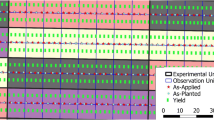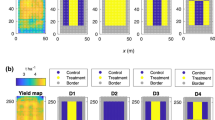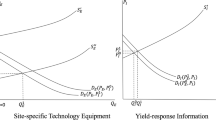Abstract
Nitrogen (N) fertilization implies two important issues: N enhances grain yields and quality, but applied in excess, nitrous oxide emissions and nitrate leaching may be induced. To reduce environmental impacts, spatial N variability in agricultural fields can be adapted using crop sensors. In on-farm experiments, sensor-based variable rate N application is compared to uniform N application, which is common agricultural practice. On-farm experiments (OFE) provide special considerations as opposed to on-station trials. In OFE, the experimental units in farmer-managed fields are considerably larger, which raises the question if soil heterogeneity may be fully controlled by the experimental design (random treatment allocation and blocking). Grain yield monitoring systems are used increasingly in OFE and provide spatially correlated data. As a consequence, classical analysis of variance is not a valid option. An alternative four-step strategy of statistical model selection is presented, generalizing the assumptions of classical analysis of variance within the framework of linear mixed models. Soil heterogeneity is preliminary identified in step 1 and finalized in step 2 using covariate combinations (analysis of covariance). Yield data correlations are handled in step 3 using geo-statistical models. The last step estimates treatment effects and derives the statistical inference. Analyses of three OFE revealed that different covariate combinations and geo-statistical models were needed for each trial, which involves higher analytical efforts than for on-station trials. These efforts can be minimized by following the steps provided in this study to find a best model approximation. Nevertheless, model selection in precision farming OFE will always accompany some uncertainty.

Similar content being viewed by others
References
Blackmore, S., Godwin, R. J., & Fountas, S. (2003). The analysis of spatial and temporal trends in yield map data over six years. Biosystems Engineering, 84(4), 455–466.
Brenning, A., Leithold, P., & Piotraschke, H. (2008). Geostatistical analysis of on-farm trials in precision agriculture. Proceedings, GEOSTATS 2008, 8th international geostatistics congress (p. 6). Santiago, Chile. http://www.agricon.de/on-farm-research/theorie/geostatistik. Accessed 20 April 2009.
Brownie, C., Bowman, D. T., & Burton, J. W. (1993). Estimating spatial variation in analysis of data from yield trials: a comparison of methods. Agronomy Journal, 885, 1244–1253.
Burnham, K. P., & Anderson, D. R. (1998). Model selection and inference. A practical information-theoretic approach. New York: Springer.
Corwin, D. L., & Lesch, S. M. (2003). Application of soil electrical conductivity to precision agriculture: theory, principles and guidelines. Agronomy Journal, 95, 455–471.
Delin, S., Lindén, B., & Berglund, K. (2005). Yield and protein response to fertilizer nitrogen in different parts of a cereal field: potential of site-specific fertilization. European Journal of Agronomy, 22, 325–336.
Ebertseder, T., Schmidhalter, U., Gutser, R., Hege, U., & Jungert, J. (2005). Evaluation of mapping and on-line fertilizer application strategies in multi-year and multi-location static field trials for increasing nitrogen use efficiencies of cereals. In: Proceedings of the 5th European conference on precision agriculture (p. 327–335). Uppsala, Sweden.
Ehlert, D., & Dammer, K. H. (2006). Wide-scale testing of the Crop-Meter for site-specific farming. Precision Agriculture, 7, 101–115.
Ehlert, D., Hammen, V. C., & Adamek, R. (2003). On-line sensor pendulum-meter for determination of plant mass. Precision Agriculture, 4, 139–148.
Gebbers, R., & Adamchuk, V. (2010). Precision agriculture and food security. Science, 327, 828–830.
Hirschfeld, J., Weiss, J., Preidl, M., & Korbun, T. (2008). Klimawirkungen der Landwirtschaft in Deutschland [climate change in Germany]. Berlin: Schriftenreihe des IÖW.
Hong, N., White, J. G., Gumpertz, M. L., & Weisz, R. (2005). Spatial analysis of precision agriculture treatments in randomised complete blocks: guidelines for covariance model selection. Agronomy Journal, 97, 1082–1096.
Hooks, T., Marx, D., Kachman, S., Pedersen, J., & Eigenberg, R. (2008). Analysis of covariance with spatially correlated secondary variables. Revista Colombiana de Estadística, 31(1), 95–109.
Hurley, T. M., Malzer, G. L., & Kilian, B. (2004). Estimating site-specific nitrogen crop response functions: a conceptual framework and geo-statistical model. Agronomy Journal, 96, 1331–1343.
Isensee, E., Thiessen, E., & Treue, P. (2003). Perennial experiences with site-specific fertilization and harvest. Agricultural Engineering Research, 9(5), E50–E62.
Lambert, D. M., Lowenberg-DeBoer, J., & Bongiovanni, R. (2004). A comparison of four spatial regression models for yield monitor data: a case study from Argentina. Precision Agriculture, 5, 579–600.
Lemaire, G., Recous, S., & Mary, B. (2004). Managing residues and nitrogen in intensive cropping systems. New understanding of efficient recovery by crops. Precision farming—Challenges and future directions. In: Proceedings of the 4th international crop science congress new directions for a diverse planet (p. 19). Brisbane, Australia. http://www.cropscience.org.au/icsc2004/symposia/2/6/936_lemaireg.htm#TopOfPage. Accessed 5 May 2008.
Littell, R. C., Milliken, G. A., Stroup, W. W., Wolfinger, R. D., & Schabenberger, O. (2006). SAS for mixed models (2nd ed.). Cary, NC: SAS Institute.
Littell, R. C., Pendergast, J., & Natarajan, R. (2000). Modelling covariance structure in the analysis of repeated measures data. Statistics in Medicine, 19, 1793–1819.
Piepho, H. P., Richter, C., Spilke, J., Hartung, K., Kunick, A., & Thöle, H. (2011). Statistical aspects of on-farm experimentation. Crop and Pasture Science, 62, 721–735.
Piringer, G., & Steinberg, L. J. (2006). Reevaluation of energy use in wheat production in the United States. Journal of Industrial Ecology, 10, 149–167.
Richter, C., & Kroschewski, B. (2006). Some considerations on the use of geostatistical methods in agricultural field trials. Part II: Comparison of theoretical considerations with results from real data. Biometrical Letters, 43(2), 67–77.
Richter, C., & Kroschewski, B. (2012). Geostatistical models in agricultural field experiments: Investigations based on uniformity trials. Agronomy Journal, 104, 91–105.
Richter, C., Kroschewski, B., Michel, V., & Zenk, A. (2007). Analysis of standard designs using spatial models. In H. Bleiholder & H. P. Piepho (Eds.), Agricultural field trials—today and tomorrow, proceedings of the international symposium (pp. 176–181), Stuttgart-Hohenheim, Germany.
Ritter, C., Dicke, D., Weis, M., Oebel, H., Piepho, H. P., Büchse, A., et al. (2008). An on-farm approach to quantify yield variation to derive decision rules for site-specific weed management. Precision Agriculture, 9, 133–146.
Schabenberger, O., & Gotway, C. A. (2005). Statistical methods for spatial data analysis. Boca Raton: Chapman and Hall.
Schneider, M., Spilke, J., & Wagner, P. (2007). Evaluation of on-farm field trials—the example of site-specific nitrogen fertilization trials. In H. Bleiholder & H. P. Piepho (Eds.), Agricultural field trials—today and tomorrow, proceedings of the international symposium (pp. 209–214), Stuttgart-Hohenheim, Germany.
Shanahan, J. F., Kitchen, N. R., Raun, W. R., & Schepers, J. S. (2008). Responsive in-season nitrogen management for cereals. Computers and Electronics in Agriculture, 61, 51–62.
Thöle, H. (2008). Nitrogen fertilization of cereal crops under Eastern German conditions. In A. Jezierska-Thöle & L. Kozlowski (Eds.), Gospodarka przestrzenna—w strefie kontinuummiejsko-wiejskiego w Polsce (pp. 449–460). Poland: Wydawnictwo Naukowe Uniwersytetu Mikolaja Kopernika.
Thöle, H., & Ehlert, D. (2010). Biomass related nitrogen fertilization with a crop sensor. Applied Engineering in Agriculture, 26(5), 769–775.
Thöle, H. (2010). Approaches for statistical analysis of on-farm trials with spatial data (Ansätze zur statistischen Auswertung von On-Farm-Experimenten mit georeferenzierten Daten). Ph.D. thesis, Humboldt-University of Berlin, Germany.
Thöle, H., Richter, C., Kroschewski, B., & Ehlert, D. (2007). Analysis of site-specific N-fertilization on-farm trials under assumption of spatial covariance structures. Agricultural Engineering Research, 13(6), 207–213.
Thorburn, P. J., Biggs, J. S., & Weier Keating, K. L. (2003). Nitrate in groundwater of intensive agricultural areas in coastal Northeastern Australia. Agriculture, Ecosystems & Environment, 94(1), 49–58.
Zimmerman, L. D., & Harville, D. H. (1991). A random field approach to the analysis of field-plot experiments and other spatial experiments. Biometrics, 47, 223–239.
Acknowledgments
This project was funded by the Federal Ministry of Nutrition, Agriculture and Consumer Protection (BMELV) in Germany. We would like to thank Rolf Adamek, Antje Giebel and Michael Heisig for their support. The authors declare that they have no conflict of interest.
Author information
Authors and Affiliations
Corresponding author
Rights and permissions
About this article
Cite this article
Thöle, H., Richter, C. & Ehlert, D. Strategy of statistical model selection for precision farming on-farm experiments. Precision Agric 14, 434–449 (2013). https://doi.org/10.1007/s11119-013-9306-9
Published:
Issue Date:
DOI: https://doi.org/10.1007/s11119-013-9306-9




